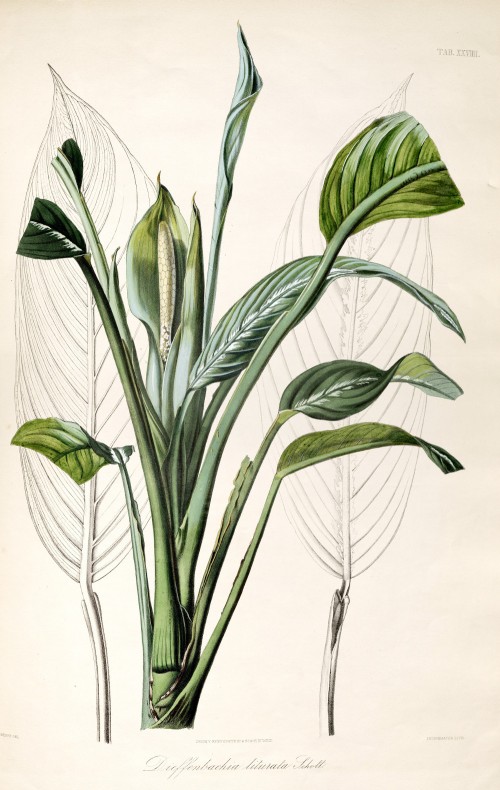Dieffenbachia seguine (Jacq.) Schott - Araceae - dumbcane, Dieffenbachie, Giftaron, Schweigrohr
Evergreen perennial, native to Central America, the Caribbean and South America; leaves large, cultivars and hybrids with various shades of yellow and green and variegated patterns.
http://en.wikipedia.org/wiki/Dieffenbachia_seguine
„Dieffenbachia may well be the most toxic genus in the Araceae. Calcium oxalate crystals, a protein and a nitrogen-free compound have been implicated in the toxicity, but the available evidence is unclear. The plants have also been used as food, medicine, stimulants, and to inflict punishment.“
[Dieffenbachia: Uses, abuses and toxic constituents: A review. Arditti, J., Rodriguez, E., Journal of ethnopharmacology, Vol.5(3), 1982, 293-302]
The toxicity of plant parts and sap has been partly attributed to their proteolytic activity.
[A cysteine protease of Dieffenbachia maculata. Chitre, A., Padmanabhan, S., & Shastri, N. V.,Indian journal of biochemistry & biophysics, Vol.35(6), 1998, 358-363]
[Novel plant metalloproteinase from Dieffenbachia seguine causes fingertip necrosis. Mirastschijski, U., Schnabel, R., Naumann, M., Kähne, T., British Journal of Dermatology, Vol.162(5), 2010, 1150-1152]
„Mother-in-law plant (Dieffenbachia seguine) is an ornamental. Chewing dumbcanes (Dieffenbachia spp.) leaves or stems causes immediate pain and swelling in the mouth and throat. In severe cases, speech may become unintelligible, hence the name dumbcane. In the past these plants were used as a means of human torture. Family pets have also been poisoned after chewing on dumbcane plant material. The effects are almost instantaneous, before the plant material is actually ingested. The plant juices can also cause inflammation and contact dermatitis in some individuals (Arditti and Rodriguez 1982, Lampe and McCann 1985). Mrvos et al. (1990) determined that in many cases where people had contact with broken leaves of dumbcane plants, symptoms occurred within 5 min and were short and of minor consequence. The researchers concluded that concerns regarding oral complications may be exaggerated.“ http://www.cbif.gc.ca/eng/species-bank/canadian-poisonous-plants-information-system/all-plants-scientific-name/dieffenbachia-seguine/?id=1370403266842

Dieffenbachia seguine var.liturata as Dieffenbachia liturata Schott;
Schott,H.W., Icones Aroidearum, t.29 (1857-1860) [J.Oberer]
http://plantgenera.org/species.php?id_species=341152
